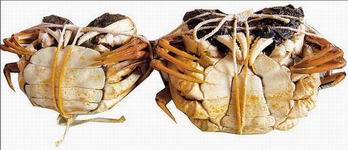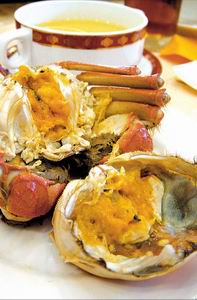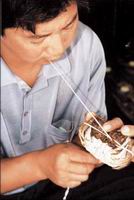Fan Meijing/Shanghai Daily news
Any fancier of crab
meat in Shanghai - and just about anywhere else in China - will tell you that
nothing can beat the superb crustaceans that come from Yangcheng Lake.
I had
long known of the high esteem in which Yangcheng Lake crabs are held but could
not understand how they had earned such a high reputation. I would ask crab
gourmets about the origin of their fame. "Why are the crabs from Yangcheng Lake
said to be the best and how are they different from crabs raised
elsewhere?"
In reply there would licking of lips, mysterious smiles and then
I would be told: "Their deliciousness is beyond words. They have to be tasted
with your own tongue."
In a recent weekend I was finally offered a chance to
make a trip of discovery to the renowned lake in nearby Kunshan in Jiangsu
Province.
Before I set off, my mother, a major crab fan who is always
recounting her great feat of eating a whole basin of Shanghai crabs in only a
few hours, urged me to taste every last morsel of the Yangcheng Lake crabs and
report back to her in detail what my feelings were.
We went to the lake by
bus. The one-and-a-half-hour journey took about an hour longer because there
were so many other tour buses on the road carrying eager crab gourmets they had
created a traffic jam at the highway toll station.
The restaurant we went to
was plainly decorated and its kitchen was so busy steaming crabs that the staff
had no time even for making tea. We waited anxiously, hungry and thirsty.
Sitting beside me was Pu Jianping, a middle-aged photographer whom I discovered
was an expert on Shanghai crabs.
Then the renowned Yangcheng Lake crabs
appeared at the table. I was thrilled. They were huge, plump and beautifully
orange.
Every year when the first blast of autumn chill is felt, it's time
for Chinese to start eating crabs - better known as "da zha xie" in Shanghai. In
lunar September people usually eat female crabs and put the males aside because
the latter are still very thin and won't be tasty for another month. The whole
crab season lasts to the end of the year.
A high-quality fully matured
Yangcheng Lake crab weighs between 220 grams and 250 grams so they're much
bigger than other varieties of Shanghai crabs. The males and females can be told
apart by looking at their claws and undersides. The pincers of the males are
bigger and covered with bushy "hair" while those on the females are
"hairless."

The belly opening section of male crabs (right) is
triangular and petal-like and round for females. The pincers of male crabs are
bigger and covered with bushy ¡°hair¡± while those on the females are ¡°hairless.¡±
¡ª Fan Meijing
"If you turn the crabs over so they are lying on
their backs you will see a section of their belly that can be opened for
extraction," Pu said, taking a crab and showing it to me. "For males, this
section is somehow triangular and petal-like. In females, it's round."

The flavorful essence of the renowned Yangcheng Lake crab
is its spawn ¡ª gao for male crabs or huang for female crabs.-China
Foto
Also, males and females taste different. To most eaters,
the biggest allure of the Yangcheng Lake crab lies not in its pure white meat
but in its spawn, which is inside its "lid." The spawn ("gao") of the males is
translucent white and has a very rich taste. The spawn ("huang") of the females
is golden yellow and also absolutely delicious. Whether "huang" or "gao" is more
appealing is totally up to personal preference.
Although it is brilliantly
colored when served at the table, the Shanghai crab before cooking is
dark-green-blue with a white underside.
"Experts can tell whether a crab is
fat by just looking at it and weighing it in the hand," Pu told me. "A 'green
hand' like you can try to pinch its claws to feel whether the meat is plump, or
look into that vent hole in the belly. If you see red leaking from its body, the
crab must be fat and full of spawn."
We started eating. We threw away our
chopsticks, stretched out our fingers and thumbs and launched into the crabs
with appetite and passion. When tackling crabs, there seemed to be no table
etiquette involved but Pu said this assumption was wrong.
"We used to use
tools," Pu said. "The most traditional tools are called 'The Crab Eights' - a
small wooden 'table' to put the crab on, hammer, axe, scissors, forceps, drill,
spoon and fork." Nowadays the number of implements has been reduced to six or
even fewer.
Crab sauce

Binding crabs is crucial to ensure a successful grand crab
banquet ¡ª if the binding is too loose, the crabs may ¡°escape¡± and you may not
have a ¡°complete¡± spawn; if the binding is too tight you may cut the claws.
After binding, steam the crabs ¡ª usually without any seasoning. Making the sauce
to go with the crabs is important, too. The sauce is generally a mixture of
vinegar, ginger, salt and sugar.¡ª China Foto/Fan
Meijing
Shanghai people are the most devoted eaters of crab meat
in China and are famous for the skillfulness in consuming them.
"In olden
times, young Shanghai ladies would be dressed in 'qipao' (a traditional Chinese
costume) and spend two hours eating a crab," Pu said. "With the help of delicate
steel, bronze or even silver tools, they would seldom stain their hands or
lips."
Steaming the crabs to preserve their flavor is the most preferred
method of cooking them. Since no seasonings are added during the cooking, to
make an excellent crab sauce is crucial. The sauce is generally a mixture of
vinegar (those made in Zhenjiang in neighboring Jiangsu Province are the best),
ginger, salt and sugar. (My mother also adds some soy sauce to make the sauce
tastier still.)
When I was going to decline the waitress to serve me a cup of
yellow wine, Pu stopped me and said it was better to sip some of the
alcohol.
"Shanghai crab is rich in protein and nutritious but its 'nature' is
very cold," he explained. "The wine helps warm up your stomach and restore the
body's slightly damaged 'yin' and 'yang,' so try a little even if you don't
usually drink."
Really, I was quite satisfied when I walked out of the
restaurant. Both my belly and my brain were full and I said to myself: "My
mother must be extremely envious of my good luck."
Now I've found out for
myself why Yangcheng Lake crabs deserve their great reputation. How exceptional
they are, as I had already been told, "is beyond words. They have to be tasted
with your own tongue."
How to get
there:
By car along the Huning (Shanghai-Nanjing) Highway to the lake. You can also
order a crab tour package with Shanghai Qiangsheng Tour Service includes bus
transport, a meal and a pair of crabs (one male and one female).
Tel:
6255-5322, 3218-0500
Crab prices: Superior crabs (250 grams for male and 220
grams for female) are sold for about 80 yuan a pair, so bargain with the vendor
if the prices are unreasonable.
How to eat
them
First, break into the exit on the underside and then open the
"lid" with fingers and thumbs. It's almost impossible to eat crabs without using
your fingers.
Now observe the inside of the "lid." You'll find the spawn
("gao" for male crabs while "huang" for female crabs) and a small clump of
intestines which should not be eaten. Use the forceps to pick them out and then
use a spoon to eat the "huang."
Scissors are used to cut the body in half.
You may use hammer and axe to crack the legs and then use forceps and a spoon to
dig out the meat.
The claws are more difficult to handle. First cut the
joints away on both sides and then, use the drill to push the meat out.
For
drinks with the meal, ginger tea may be a substitute for yellow wine if you
really don't want to drink alcohol.
Please remember, patience is necessary to
fully appreciate the crab's deliciousness and to enjoy the whole process of
eating it.
Crab tools are on sale on eBay.



